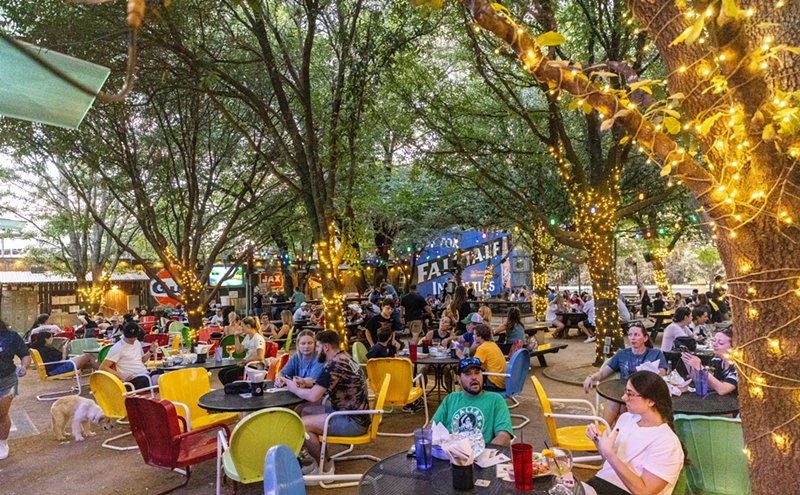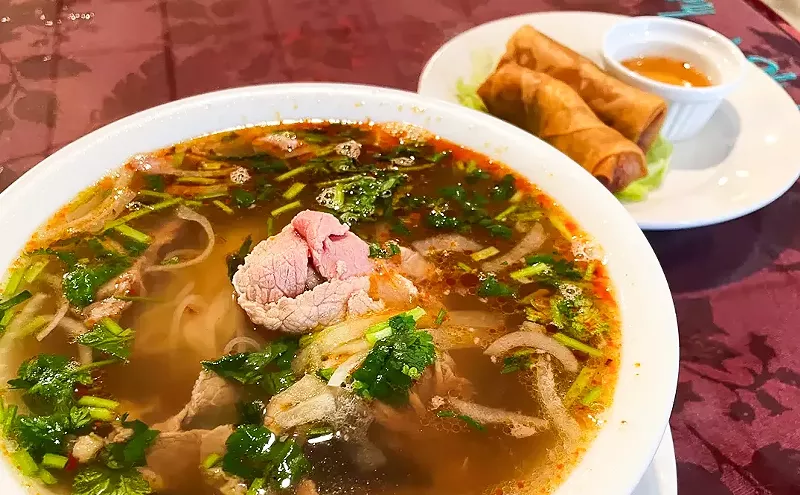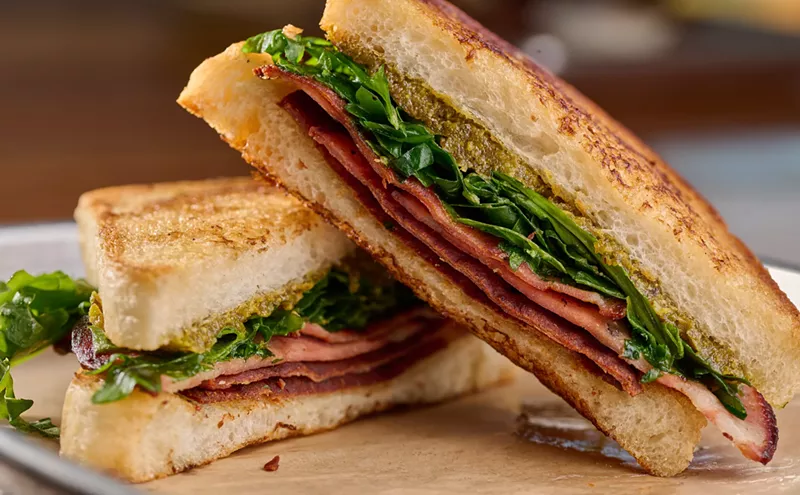Sometimes when a restaurant is struggling, all it needs is a new face to turn the whole thing around. In the short tenure of Chef Richard Gras, Oak went from earning four stars when Jason Maddy was chef to scoring only three from Dallas Morning News food critic Leslie Brenner. After Gras tendered his resignation this summer, Chef Brian Zenner was brought in to revitalize the struggling design district spot.
Before working at the recently-shuttered Belly and Trumpet, which is owned by the same restaurant group, Zenner helped open Oak with Maddy. Oak has since been restored to its four stars with Zenner's "globally influenced soul food" on the menu, giving the restaurant a new luster that it seemed to lack during Gras' tenure. I sat down to talk with Zenner about breathing new life into Oak, played out restaurant tropes, and why it's difficult for a fine dining restaurant to make it in Uptown Dallas.
It seems like just a few weeks ago that I was in here interviewing Chef Richard Gras. After coming in and taking over, what did you see that needed to be fixed or changed?
I wouldn't say needed to be fixed.
Is that because you're a nice guy, or because things were really working pretty well here before you came?
I would say that when I got here, we just changed everything. It happened really fast, in this super accelerated process. I wanted to come in and put different food out there for the customers, my food. I started here when this place opened, so I brought back some plays on old dishes we had here back then. But we changed every single dish in about two weeks. Part of that was because we knew that a review was coming, so everything had to be tweaked and I wanted to put food out there that was mine. Something I could stand behind.
Were you concerned about taking over a restaurant that had lost a little of its luster?
It's tough to follow a legend, and Jason had reached some serious heights here. It was easier to follow Richard than Jason just because expectations were different. But I'll just say this -- if Bruno Davaillon ever left the Mansion, I would hate to see the chef that had to follow him there.
What do you think that you did differently that made the difference between the third and fourth star for Oak from Leslie Brenner?
I only ate here a few times, so I really can't say. There's definitely a different philosophy. Chef Gras could tell you more accurately about his philosophy on food, but I try to keep things simple. Keep things clean and bold, and not have too much going on the plate. If something is supposed to taste like mushrooms, it's really going to taste like mushrooms. I also think we got a little more global on the menu than it was. I have a strong Thai influence in a lot of the food I do, along with Spanish and Moroccan food.
I'm guessing that the difference between three and four stars was the food. We have the same service staff, same wine, same restaurant, and she seemed to like that. This was her third review of the restaurant, and it was four stars, then three, and now back to four again. I read the review of Chef Gras' time here, and it seemed like there were some execution problems that they had in that specific review. I wasn't here in the kitchen, so it's hard for me to say what the difference is. Execution and consistency are really big deals for her and everyone else.
I think flavor-wise, I think there was a little more simplistic view on food in that I think it's okay to make foods that aren't quite so fussed up. Focusing less on the process of making the food and less about what's on the plate. I was fortunate to get a positive review when I was at Belly and Trumpet, so I guess she has an affinity for my style of cooking.
Speaking of Belly and Trumpet, do you have any thoughts on what happened there, why the restaurant closed? Was it the crowd? Location?
I think it was a confluence of the restaurant, the crowd, and everything else. It was a challenging location for us. The parking is removed from the actual building, the Uptown address would sometimes make people pause. With the review, I think we kind of got slated as a fine dining restaurant, and we weren't trying to be fancy in any way. And that's really not what's going on in Uptown very often. I'm not sure why the crowds stayed away. The size of the place was a challenge, but I'm really proud of everything we did there. It hurt a lot.
It seems like Uptown is just a difficult place to hack it, especially if you aren't a very specific kind of establishment that fits into the feel.
I'd agree with that. Anything labeled as fine dining, and we weren't even overly expensive, they're going to have a challenge. After Primo's left, So & Sos opened and they've got people going out the door. It's slammed. I guess you have to have more of a focus on the bar element in that area, and we were were much more of a straight ahead restaurant.
When you worked here at Oak with Jason Maddy, it was such a success. Are there some things from that time that you wanted to recreate in your own way?
Absolutely. We brought back the Caesar salad that everyone loved. It's not exactly the same, but calls back to it. It was called Legurian Caesar and made with mint and basil in the dressing, and we just sold a million of them. The brussels sprouts were also hugely popular with our customers, and those will probably be coming back once we hit brussels sprout season. Dish for dish? No. When I sat down at day one, I wanted to look at what we did then as the overall layout of the menu and try to get back to that formula.
How would you describe that formula that you were working toward?
We'd lost about four or five dishes from the menu from when Jason and I were here and when I showed up after Chef Gras, and the menu was small. I'm not sure customers appreciated the small selection. We wanted to get some more options out there, not just in flavor but also in price and expand the menu by four or five items.
It's interesting that you bring up menu size. On Facebook the other day, I saw Michael Martensen of Proof + Pantry responding to a reviewer who made a stink about how small the menu was and not having a lot of options. Menus seem to be shrinking, but how do you find the balance between too small and too big?
That's the million dollar question, right? It's about having a menu that is achievable in the kitchen and that you can consistently execute. Owners want more on the menu, and chefs usually want less. I think most chef-driven places go with a smaller menu, especially in an American cuisine type restaurant because you can just make fewer things better than throwing 30 things out there to keep customers happy. People want selection, but I think the trend of smaller, more specialized menus is going to stick around. But it all depends on the restaurant, really. I don't want to marginalize all the dishes just to have a few extra appetizers or whatever on the menu.
In terms of diversity, you mention that people want options. What options do people want here in Dallas?
Yes. There's no commandment, but that's how I want to think about it. It means offering a skin-on fish, a whitefish, and going within a few categories. You need poultry, you've got to have some kind of pork or boar. Maybe some kind of game, like some venison or elk. The beef dish is obvious, and there's usually a braised dish that falls into there somewhere. You also need a middle-of-the-road dish, something meat and potatoes, that always helps.
When you say that it helps, do you mean that because that's what people want when they go out to dinner?
If you have a four top, let's say two couples, one of those people isn't going to want to eat sardines. It's about being accommodating. The number one rule is to make people happy. We're not a hotel, but we're not here to say "it's my way, or get out." If somebody feels like there aren't enough options because they want meat and potatoes more than a piece of bronzino, we have to accommodate that.
But I think chefs sometimes pigeonhole themselves into thinking that they only have to do these wildly creative dishes and be constantly introducing new crazy dishes. Do you feel pressured to do that? Not really. We have a prime tenderloin that comes with fried egg, hashbrowns, and foie gras on top. Sure, there's a limitation by saying that you're going to do a steak and potato dish, but you have to challenge yourself and make something really great out of it. We have a baby green salad on the menu, but it's a really great plate of greens. Do I order the mixed green salad when I go out? No, but a lot of people do. There's no right answer. I'm not right, and someone else isn't wrong. Other restaurants have a much different concept of what they want to put out, and they're very successful at it.
Do you think chefs limit themselves by thinking that they can't put certain dishes on the menu? Like a beet salad for example.
I do feel like that at times. It's confining, but you can still be innovative. We do a caldo verde, which is as basic as a soup you can offer, so I'm okay doing the most simple dishes. The term I came up with is "global soul food," because that's what I enjoy most. Something you get from a street vendor or market. That's my favorite food, no matter wherever you are. But food is the same. All dishes are limited and confining based on what you have in your head. If all you can come up with is a boring beet and goat cheese salad, well, then you have a different problem.
Are there any dishes that you do think are just too played out and cheesy to throw on the menu?
Macaroni and cheese might be one for me, but it works for other people. But is there any dish too cheesy to throw on a menu ever without any exceptions? No. No way.
What about other restaurant staples? What do you think is the most played out thing that restaurants insist on doing?
Peppermints when you walk out the door? I don't know. Ties on waiters aren't always my favorite, but nobody really pays attention to that stuff. Bread service. That one pains me sometimes. It's this begrudging thing, and I feel like I don't always want you to eat half a loaf of bread when you're about to eat my dinner. It's not my choice. We choose to do bread service.
At the Mansion, they have little demi baguettes, and I always thought that should be it. That's all you get. That's the fun part of having bread at your table, not just gorging on it. Restaurants figure out a cool and creative way to do it, but it's basically like doing the beet salad and trying to make it different. I applaud places like Gemma that do something more interesting than just handing out bread, but maybe we don't need it.
You just released a new fall menu...
Well, I wouldn't really call it fall. It's not fall yet. Just because we're in the middle of a little cool spell doesn't mean that it's fall. When I was here a few years ago, we put this sweet potato risotto on the menu about this time of the year, and it was 90 degrees every day for the next few weeks. Every time we sent one of those out, I would just feel so sorry for whatever poor person who was ordering it. A hot bowl of rice? Really? I'm patiently waiting for fall.
So you are going to do a fall menu?
No, some dishes are somewhat impervious to seasonal change, but we'll be changing out vegetables as we go into fall. It's probably going to be more like it was at Belly and Trumpet where we have this constantly evolving menu of rotating dishes. I get tired of cooking dishes sometimes, something changes and we can't get a product anymore, and that means it's time for a new dish. Not necessarily just because these three months are fall or whatever.
Is it difficult for your customers to deal with that? I look at a lot of restaurant menus, and then walk in the door and realize that the menu is completely different from what I saw online.
People really do that? I'm sure I'm the oddball diner here, but I didn't realize that was a thing. I think certain people rely on certain dishes being at their favorite restaurants, and there are those who go out and just want something new every time they go. We're not going to change the menu as much as we did at Belly and Trumpet. In that year, we probably did over 300 dishes, and that's just not going to happen again. I'm sure people had no idea what our menu was until they got there. But it will be a little more grounded here, more stable. At a bigger establishment like this, it's not quite as easy to change as quickly as you can at a small restaurant like Belly & Trumpet.











